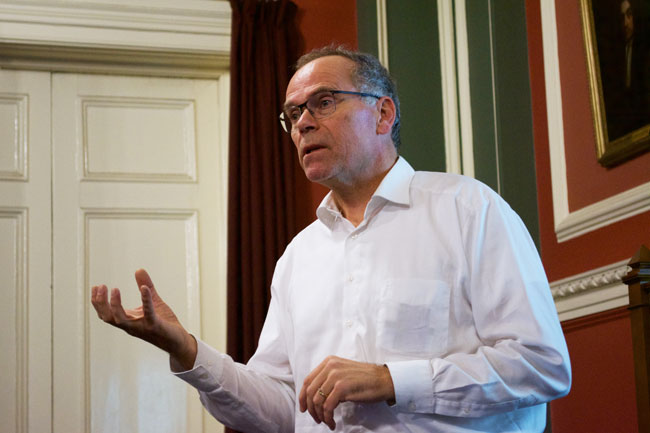
Yesterday afternoon, the Global Development Society and DU General Science Society welcomed Mark Post to the Graduates Memorial Building (GMB) to address students in a talk entitled “Meat The Future”. Lasting approximately 40 minutes, with a brief Q&A session at the end, the talk was a relaxed and informal affair, with Post staying on for the drinks reception in the University Philosophical Society (the Phil) Conversation Room to talk to the students on an informal level.
To those of you who don’t know who Mark Post is, or have never heard of his “post-burger”, he is the first man to develop a burger in a laboratory without the meat being taken directly from the flesh of a cow. The first post-burger was tried and tested live on a television show in August 2013 and, other than being a bit dry, it was received very well by its critics.
So what is this post-burger, and how is it made? The process of making this burger begins with mixing stem cells and combining them with collagen to create small strands of muscle tissue. One burger requires approximately 20,000 of such strands, and each of these has to be individually harvested from their petri dish and then assembled into the patty. Previously, the production of this cultured meat required the use of Fetal Bovine Serum (FBS), which inevitably required cows mid-pregnancy to be slaughtered, but the burgers can now be made simply by obtaining a small sample of tissue from a living cow.
All the scientific jargon aside, I can hear meat lovers screaming inside: “Why would you even try to feed me this, that sounds disgusting?” When you think of it really, though, it isn’t. The meat in these burgers is guaranteed pure muscle tissue and has none of those nasty additives you hear stories about of being discovered in sausages and cheap conventional burgers. In addition, with pressing climate change issues, it is more important now than ever that we review our dietary choices in our efforts to heal our planet.
If Post’s work has managed to open your mind to the thoughts of eating a post-burger, you may want to know where you can get your hands on one – and how much it may cost. The first post-burger cost a whopping €250,000 due to the initial capital and research investments. Today, one of these in-vitro beef bites would leave you no more than €10 out of pocket, and it’s expected to be on the market in the next three years.
Furthermore, Post predicts that, with their ongoing research and ever-evolving technology, they will be able to offer the burgers at an even lower price when they finally hit the supermarket shelves. So, keep your eyes peeled for when these burgers are in your local shop or on the menu at your favorite restaurant. Meat the future: the post-burger era has arrived.






